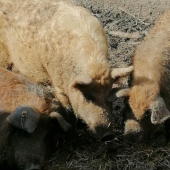
























Emile Species wrote:Also, isn't their potential for breeding problems between a guinea hog or pot belly and larger breeds?




A human being should be able to change a diaper, plan an invasion, butcher a hog, conn a ship, design a building, write a sonnet, balance accounts, build a wall, set a bone, comfort the dying, take orders, give orders, cooperate, act alone, solve equations, analyze a new problem, pitch manure, program a computer, cook a tasty meal, fight efficiently, die gallantly. Specialization is for insects.
-Robert A. Heinlein




Emile Species wrote:I wanted to ask Walter Jeffries if his York's leaned more old style or more modern type hogs. I am very interested in this topic because I am considering starting a fairly sizable operation 100-200 total head, but I plan on starting small with a few litters.

|
There is no beard big enough to make me comfortable enough with my masculinity to wear pink. Tiny ad:
12 DVDs bundle
https://permies.com/wiki/269050/DVDs-bundle
|
